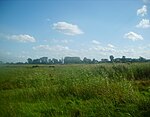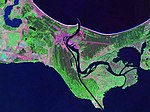Świnoujście Lighthouse
1828 establishments in PrussiaBuildings and structures in West Pomeranian VoivodeshipLighthouse museumsLighthouses completed in 1828Lighthouses completed in 1857 ... and 3 more
Lighthouses in PolandMuseums in West Pomeranian VoivodeshipŚwinoujście

Świnoujście Lighthouse (Polish: Latarnia Morska Świnoujście) is an active lighthouse in Świnoujście, Poland. At a height of 212 feet (65 m) it is the fifteenth tallest "traditional lighthouse" in the world, as well as the tallest brick lighthouse, and the tallest in Poland. It is located on the east bank of the river Świna just inside the entrance.
Excerpt from the Wikipedia article Świnoujście Lighthouse (License: CC BY-SA 3.0, Authors, Images).Świnoujście Lighthouse
Kasztanowa, Świnoujście Chorzelin
Geographical coordinates (GPS) Address Website External links Nearby Places Show on map
Geographical coordinates (GPS)
| Latitude | Longitude |
|---|---|
| N 53.915979 ° | E 14.28434 ° |
Address
Latarnia morska Świnoujście
Kasztanowa
72-602 Świnoujście, Chorzelin
West Pomeranian Voivodeship, Poland
Open on Google Maps










